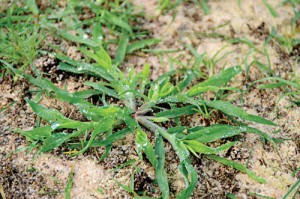Simulated rainfalls influence on large crabgrass control with herbicides
By Jim Brosnan, Ph.D., Greg Breeden and Javier Vargas, University of Tennessee
Large crabgrass (Digitaria sanguinalis) is a widespread turfgrass weed throughout the Transition Zone southward. Herbicides containing quinclorac (Drive XLR8, Solitare) often are used for selective large crabgrass control. Current labeling indicates that foliage must remain dry for 24 hours after applying these herbicides. Because quinclorac enters susceptible weeds through both foliar and root tissue, rainfall within this 24-hour period may not negatively influence efficacy, so turf managers may have a greater window of opportunity to make applications for large crabgrass control.
Research conducted at the University of Tennessee at Knoxville from 2011–2013 evaluated effects of simulated rainfall timing on the efficacy of Drive XLR8 and Solitare for large crabgrass control. Plants were propagated in greenhouse culture and treated with Solitare (1 and 1.3 lb./acre) or Drive XLR8 (64 fl. oz./acre). Per label instructions, Solitare was applied with no surfactant and Drive XLR8 included a methylated seed oil surfactant at 1.5 pint/acre. A non-treated check was included for comparison. Applications were made using a CO2-powered boom sprayer calibrated at 30 gallons/acre. Large crabgrass plants were at the 1-3 tiller growth stage on the day of treatment. An enclosed spray chamber applied about 1 inch of simulated rainfall to treated plants over the course of 5 minutes. Rainfall was applied at 0, 0.5, 1, 2, 4, and 12 hours after treatment.
Under the conditions of these experiments, heavy (about 1 inch) simulated rainfall as soon as 0.5 hours after application had no effect on large crabgrass control with either Drive XLR8 or Solitare. However, when averaged over all simulated rainfall timings, Drive XLR8 efficacy for large crabgrass control exceeded Solitare.
Our findings show that a heavy (about 1 inch) simulated rainfall as soon as 0.5 hours after application had no effect on large crabgrass control with Drive XLR8 or Solitare. This information could provide turf managers a greater window of opportunity to apply these herbicides for large crabgrass control.
Photo: Jim Brosnan, Ph.D.










